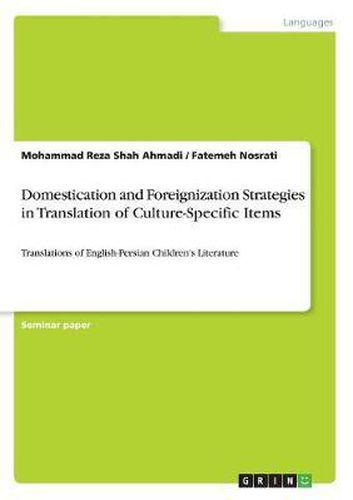Readings Newsletter
Become a Readings Member to make your shopping experience even easier.
Sign in or sign up for free!
You’re not far away from qualifying for FREE standard shipping within Australia
You’ve qualified for FREE standard shipping within Australia
The cart is loading…






Seminar paper from the year 2014 in the subject Interpreting / Translating, course: translation, language: English, abstract: Culture-bound elements, such as proper names, food items, and idioms not only place the story of a book in a specific culture and period of time, but also imply certain values. These elements also have an effect on how the reader identifies with the story and characters. So, it is important to find the most appropriate strategy to translate such elements. The objective of this paper is to find out what the most frequently used strategy in translation of culture-specific items in children's literature is. To this end, Venuti's (1995) model of domestication and foreignization strategies was adopted as the framework. The culture-bound terms were classified based on Toponyms, Anthroponyms, Means of transportation, Date, Food and Drink, Idioms, Measuring system, Scholastic reference. In the process of tracking down the culture-specific items the model proposed by Pedersen (2005) has been used. To collect and analyze the data, first, the researcher compared ten successive pages, selected randomly, of each of the selected English children's stories (Daddy long legs by Jean Webster, Anne- of- Green-Gables by Lucy Maud Montgomery, the Adventures of Tom Sawyer by Mark Twain, and The Prince and the Pauper by Mark Twain) with their Persian translation to identify culture-specific items. Next, the strategies used by the translator were identified and their frequency was calculated. The results, then, were presented in some tables. According to the obtained results, although both domesticating and foreignizing strategies have been used, foreignization has been the most dominant cultural translation strategy in children's literature.
$9.00 standard shipping within Australia
FREE standard shipping within Australia for orders over $100.00
Express & International shipping calculated at checkout
Seminar paper from the year 2014 in the subject Interpreting / Translating, course: translation, language: English, abstract: Culture-bound elements, such as proper names, food items, and idioms not only place the story of a book in a specific culture and period of time, but also imply certain values. These elements also have an effect on how the reader identifies with the story and characters. So, it is important to find the most appropriate strategy to translate such elements. The objective of this paper is to find out what the most frequently used strategy in translation of culture-specific items in children's literature is. To this end, Venuti's (1995) model of domestication and foreignization strategies was adopted as the framework. The culture-bound terms were classified based on Toponyms, Anthroponyms, Means of transportation, Date, Food and Drink, Idioms, Measuring system, Scholastic reference. In the process of tracking down the culture-specific items the model proposed by Pedersen (2005) has been used. To collect and analyze the data, first, the researcher compared ten successive pages, selected randomly, of each of the selected English children's stories (Daddy long legs by Jean Webster, Anne- of- Green-Gables by Lucy Maud Montgomery, the Adventures of Tom Sawyer by Mark Twain, and The Prince and the Pauper by Mark Twain) with their Persian translation to identify culture-specific items. Next, the strategies used by the translator were identified and their frequency was calculated. The results, then, were presented in some tables. According to the obtained results, although both domesticating and foreignizing strategies have been used, foreignization has been the most dominant cultural translation strategy in children's literature.